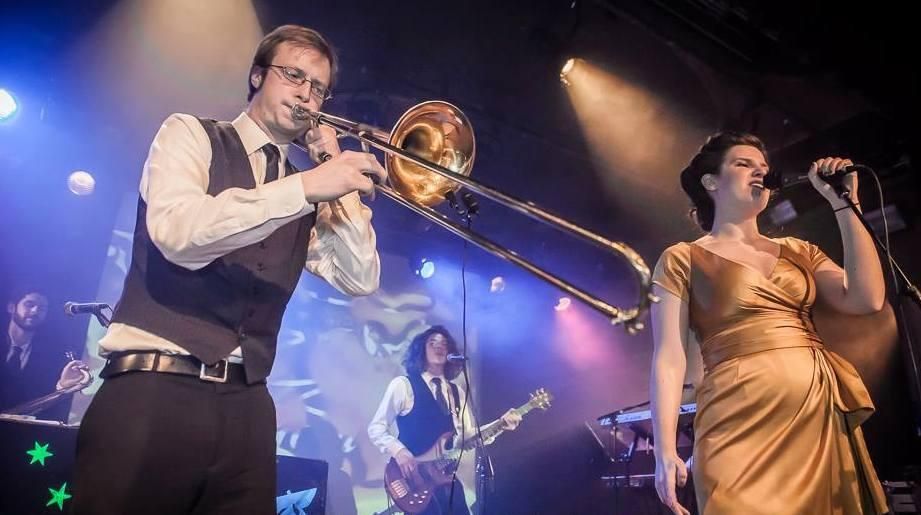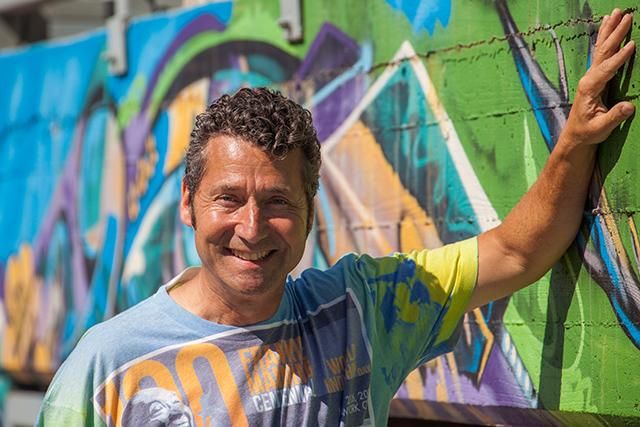This Is How You Live Paint an Event
Artist Jeremy Sutton painted on his iPad while musicians performed and visitors played virtual reality games at the Smithsonian American Art Museum
/https://tf-cmsv2-smithsonianmag-media.s3.amazonaws.com/filer/dc/09/dc09263b-98bc-4689-8161-79d52e1a9fb6/2015-06-27-america_now_at_saam_live_event_painting_by_jeremy_sutton-1280x726c.jpg)
“I’ve got my dance shoes,” said San Francisco artist Jeremy Sutton minutes before ascending a riser to draw a three-hour, live digital painting of the musicians, booths and mingling guests in the Smithsonian American Art Museum’s Kogod Courtyard.
Eyeing Sutton’s black-and-white wingtips, trumpet player Carey Rayburn, who leads the Seattle-based Good Co. electro swing band, agreed. “Yes,” he said. “Those are spanky.”
The June 27 event, spotlighting innovation in art, was the last in a three-part “America Now” series, organized by the National Portrait Gallery, National Museum of American History and the American Art Museum. As Sutton painted, his real-time depiction of the party loomed on a big screen.
Sutton and girlfriend Peggy Gyulai (herself an artist) were among the dozens who danced during Good Co.’s and DJ Eliazar’s (Eli Hason) performances. The wingtips also echoed the white “swirl” of a huge balloon that architect Nathalie Pozzi designed for the courtyard as part of video-game designer Eric Zimmerman’s “Starry Heavens” game. In the game, whose name derives from a quote on Immanuel Kant’s tombstone, silent players try to overthrow a ruler.

Sutton’s painting, in a way, bound together all of the many parts of the event: the musicians, the “Starry Heaven” players and the stations where visitors could play virtual-reality, Oculus Rift games and immerse themselves in other digital worlds. Everything, after all, was fair game for his brush, or more accurately, his Wacom Intuos Creative Stylus 2 and his Pencil by FiftyThree. But everyone in the lot also had something in common—they all straddled the border between art and technology.
Take Sutton’s iPad stand. A palette that he bought at Amsterdam’s Van Gogh Museum (based on the size and shape of Vincent’s palette), it bears paint from times when Sutton used old-fashioned brushes and paint to work atop a digital painting printed onto canvas. Sutton has rigged the palette so that he has two places to connect an HDMI cable to his iPad.
Programmer and game designer Greg Aring brought his Oculus Rift “experiences,” or games, “Hellicott City”—a haunted wagon ride whose name, presumably, derives from Aring’s hometown Ellicott City, Md., and which he spent about 120 hours making for a Halloween art show—and “Vrolleyball,” which he said is a combination of volleyball, baseball, karate and pong.
“Games have come a long way as an art form in the eye of the public,” Aring said. “There’s always been a debate about whether games are art, which I think is a silly question. Just the fact the Smithsonian would put on an event like this is really encouraging. It’s a good sign for supporting local, game developers—people who do art and like technology like myself.”
The American Art Museum hosted “The Art of Video Games” in 2012, an exhibition that celebrated 40 years of the medium with vintage gaming systems, filmed interviews with game designers and opportunities to play groundbreaking games. In 2013, the museum acquired two video games, “Flower” and “Halo 2600,” for its permanent collection, noted chief of external affairs Jo Ann Gillula.
A nine-year-old named Gabriel, who played “Hellicott City” and whose mother requested be identified only by his first name, said the game was “not really that scary,” despite the appearance of “ghosts and stuff like that, and witches.” The best part, he said, was a very speedy roller coaster scene. “It’s very nice, exciting,” he said.
Other visitors chose, in between sipping “Starry Heavens cocktails” of Limoncello di Capri and a fruit juice concoction, to play the “Starry Heavens” game.
Architect Nathalie Pozzi, who designed the balloons, admitted that at first blush, her work seemed the least technological. There were two big balloons, a very large spherical yellow one (like a stylized sun) and an enormous "swirl" that floated above, and a board below where the players stood. The "ruler” spoke from a microphone, and the other players tried to maneuver about to overthrow him or her. “Although the game isn’t digital, the construction wouldn’t be possible without it,” she said, noting that she began sketching with pencil and paper, but that the construction got quite complicated with fans keeping the balloons inflated and 3D printing involved.
And, as one would expect, the musicians too had plenty to say about the intersection of art and technology. DJ Eliazar makes a point of leaving his laptop behind when he performs, he said, so that he can appreciate what he called his art’s psychological and sociological aspects, of interacting with and reading the audience. If the crowd looks exhausted, for example, he might play something mellow to calm them down.
“There are too many options inside the computer and you get sucked into the screen and you’re not interacting,” he said. Still, he added, technology is vital to deejaying. “I couldn’t do what I’m doing without it,” he said.
Sasha Nollman, a Good Co. vocalist, noted that the band has a really strong attachment to traditional jazz, but also a deep love for electronic music. “It’s very exciting to us that we do mix those two things together,” she said. “Being invited to an event where it’s all about doing that, about innovating these older traditional forms of music, that’s very exciting.”
“Jazz is America’s music. It’s our national art form,” added trombonist Colin Pulkrabek. “We have a definite ownership of it. For that reason, we need to keep it alive and constantly reinterpret it as we see fit, and try and keep it relevant to ourselves.”
The musicians—both of Good Co. and DJ Eliazar—agreed that it was pretty exciting to be painted in real time. Good Co.’s bandleader Rayburn recalled a guy at a prior concert in Eugene, Oregon, coming up after the show and drawing caricatures of the musicians. “That was awesome,” he said. Asked if the drawings were flattering, he volunteered, “Mostly. One of them kind of looks like a wizard.”
DJ Eliazar has performed at art openings before, where the artist was sketching him. He enjoyed watching his music influence the artist. “You play something and all of a sudden it goes into their piece of art,” he said, recalling some Middle Eastern music he played at a prior event. “All of a sudden a camel appeared in his painting.”

Sutton, the digital painter, said he has been creating art at live events pretty much from when he first picked up a computer. A 1991 party changed his life in more ways than he could have known, the London native who studied physics at Oxford University said. Sutton had been living in Palo Alto since 1988, where he was selling superconducting magnets, when, as he was wont to do, he found himself sketching people at the party. Someone looking over his shoulder liked what she saw and offered to introduce him to a friend who made painting software.
“I had no idea what they were talking about but I said, ‘Of course. I’d love to,’” said Sutton, who was soon learning the program PixelPaint Pro. “That changed my life. I fell in love with this whole medium,” he said. “I felt at home with it right away.”
Despite working in a physics studio, he admitted embarrassedly he had hardly ever used a computer before being introduced to digital paint. But soon he was taking time off work to travel to Las Vegas to demonstrate how he was using painting software at the creator’s booth at the graphics show Siggraph. After losing his job, he became a full-time artist, something one doesn’t do, he says, unless you has a certain blend of complete naivete, obsessiveness and a bit of craziness.
“It’s not a recipe for any of the things that provide security,” he said.
While painting at the “America Now” event, as he always does, Sutton had his feet firmly planted in both the technological and aesthetic worlds, appearing to share things in common with both the purists who eschew digital brushes and the technology evangelists who see great promise in digital art-making.
He avoids using the “undo” button, instead adding layers of color rather than subtracting. And he doesn’t use the “eyedropper” tool, which would allow him to replicate exact colors he used earlier in his paintings. Instead, he adjusts the hue, saturation and tone afresh each time. While talking to a reporter the day before the event, he demonstrated how quickly he could match the red color on a coffee cup on his drawing program; it took a matter of seconds.
“I treat my media as a very malleable, transformative media,” he said. “It’s not correcting; it’s always transforming.”
In the painting he created on June 27, Sutton built upon a background that he composed from three works from the American Art Museum’s collection: Malcah Zeldis’ “Miss Liberty Celebration” (1987), Marvin Beerbohm’s “Automotive Industry” (1940) and Romare Bearden’s “Empress of the Blues” (1974). Several of the musicians from Bearden’s piece appear prominently in Sutton’s final painting, as do Good Co.’s Sasha Nollman (in a distinct blue dress), Pulkrabek’s trombone, DJ Eliazar’s hat, the balloon swirl and the courtyard ceiling. Sutton often took breaks from the work, which he created with the app Sketch Club, to talk to visitors of all ages about his work, the classes he teaches mostly at his San Francisco studio and his techniques. Interacting with the public in this way, girlfriend Gyulai confirmed, is something he enjoys very much.
Perhaps more emblematic of the intersection of technology and art than even his iPad easel is the way Sutton draws on his physics training in his artmaking. Both approaches to viewing the world, he said, have a great deal to do with seeking patterns, structure and rhythm, and then being critical about what appears on the surface.
“It’s about seeing things beyond what you at first see,” he said.
/https://tf-cmsv2-smithsonianmag-media.s3.amazonaws.com/accounts/headshot/mw_by_vicki.jpg)
/https://tf-cmsv2-smithsonianmag-media.s3.amazonaws.com/accounts/headshot/mw_by_vicki.jpg)